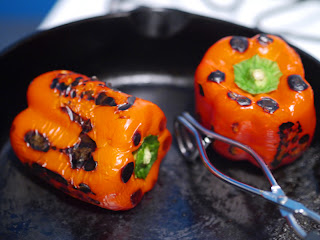Ugh. There comes a time when a blogger becomes accountable to her blog - even despite the modest number of viewers of this one here. I write this for myself, really. Otherwise I suppose I would have stopped a while ago. At some point, I'd like to have a repository of tested and tried recipes that I can refer to as my culinary "repertoire." It's been very nice to leaf through this blog at times and remember what I was making last year, what type of food I was into and what I was buying. It's a lot like browsing through photo albums with photos of you at all ages. I believe we are what we eat so I, too, was at every point in time the embodiment of my dietary creed of that period. Think of these posts as my self-portraits, if you will. (and yes, I'm aware my last post was a pizza)
At some point, you become responsible for posting regularly, for putting good content "out there," because, let's face it, this is the Internet and any kitchen klutz could find my blog through a really unlikely chain of events, and decide they want to try, say, my zacusca recipe. So you see, I can't in good conscience promote recipes that I don't honestly consider absolutely glorious. What kind of person would I be, really, if I purposefully led some culinary naives astray? And with the two readers (thanks mom and dad) that I have, could I afford gambling any credibility, should an innocent viewer happen upon this blog?
So I test this stuff. I test it a lot. There are countless dishes I make that don't turn out that great and that I wouldn't really recommend. I take photos each time, but few make it to the blog. This page, really, is for memorable meals.
Since I'm now so blissfully zen (you know you envy me) and eat more leaves than a ruminant animal, I'm also more interested in intellectual enlightenment. Which is another way to say I kind of miss being in college. You know, using polysyllabic words and philosophizing with whomever would care to listen. So with all the nostalgia, I've been taking loads of classes on Coursera - in case you didn't know, it's an awesome platform for free online courses from top universities in the US and the rest of the world. I love Coursera. Anything you could care about, they have a course about it. It's terrific. It's been keeping me busy lately and I've hardly had time to write. But it's worth it.
I haven't stopped cooking though. A girl's got to eat, after all. A while ago I made this beef and eggplant moussaka, which is a mixture of my memories from home, some recipes I've found online and my own intuition. It's definitely a winner. I very seldom eat red meat, so this is definitely a special occasion. I've also made a vegetarian version of this, which I'll be happy to post at some point. For now, remember to buy beef only from local, happy cows, and enjoy this feast!
Eggplant & beef moussaka
~ serves 6
2 medium eggplants, cut into 1/2-inch slices
1 28-oz can chopped tomatoes (I use Pomi)
1 medium yellow onion
1 pound ground beef from local, happy cows
1 cup shredded cheese (goat Gouda or cheddar will work)
1 Tbsp dried mint (basil, oregano will also work here if you don't have mint)
olive oil
salt, pepper, to taste
In a pot over medium-low heat, pour about 2 tbsp of olive oil. When the oil is hot, saute the onions until transparent, about 3 minutes. Add the ground beef and cook until brown, stirring constantly, about 10 minutes or so. Gradually add the chopped tomatoes, then add the mint and cook for another 5 minutes (Note: if the mixture if getting too liquid, don't add all the tomatoes).
Preheat the oven to 350. Take a 9 x 13 or similar baking dish and oil it well inside. Put a layer of eggplant slices (there will be 3 of these, so plan for it) and sprinkle a little salt. Then put a layer of the ground beef mixture (there will be 2 of these, so put half). Another layer of eggplant slices, a little salt, another layer of ground beef, and finally eggplant at the very top. You don't have to sprinkle salt on this one, just the cheese and some nice herbs (I chose basil).
Bake covered for 45 minutes, then leave uncovered for the last 15 to give it a nice brown color. Voila!
Questions are welcome! Leave a comment below.























